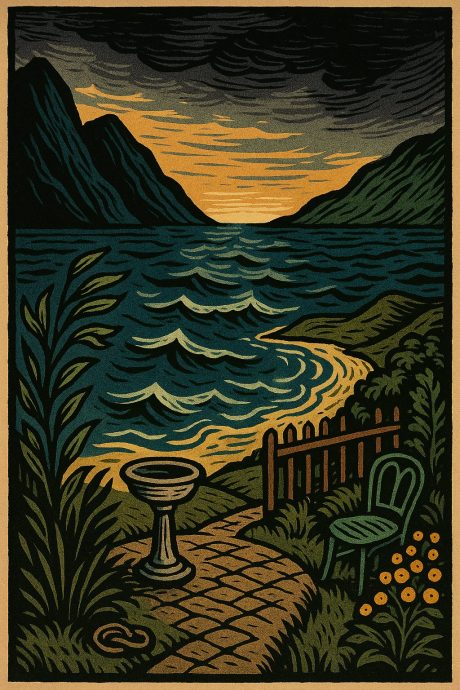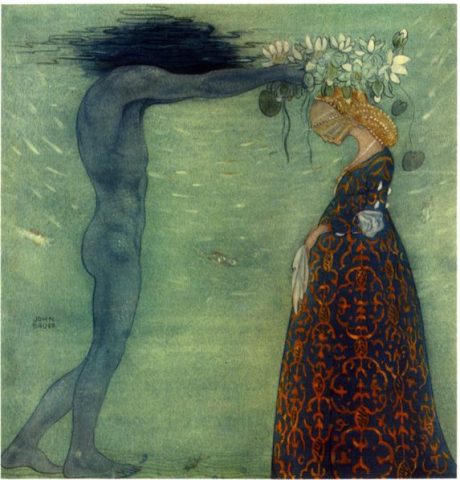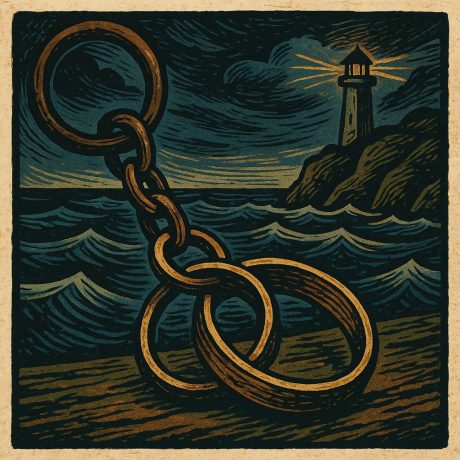
I saw The Lady from the Sea at the Bridge Theatre on Saturday 4 October. It was fascinating, beautifully acted, and emotionally resonant — but something essential had been tamed. Simon Stone’s new English version, starring Alicia Vikander as Ellida and Andrew Lincoln as Edward, recasts Ibsen’s haunting drama as a domestic, psychological story of healing. While powerful in its intimacy, the adaptation loses the danger, myth, and mystery that make Ibsen’s Fruen fra havet so unsettling.
In Ibsen’s Norwegian original, the play is charged with elemental dread: the sea, havet, speaks as an ancient force of death and desire. Ibsen was inspired by a folk song, Agnete og Havmanden, Agnete and the merman, in which a spirit of the sea lures a mother to escape with him into the waves. Ibsen’s play has the flavour and tone of this folk tale, but merges it with an uncanny realism. The play is full of Chekovian subtext; nothing is explicitly stated. This, for me, is Ibsen’s great achievement in his greatest plays: for all his dramatic realism, the plays such as The Master Builder, A Doll’s House, Hedda Gabler, all have a mythic quality.

In the play, as in the folk song, the figure of the merman, named the Stranger (den fremmede), is a murderer, a spectral figure who embodies the erotic and destructive power of freedom. In Stone’s translation, he becomes a wounded lover: human, relatable, no longer mythic, and crucially, no longer a murderer.
The Guardian’s preview of the Bridge production reveals that Stone writes fluidly, often rewriting dialogue mid-rehearsal. This process gives the text modern energy but replaces Ibsen’s elliptical poetry with articulate realism. The result is compelling, but less strange. Below are five lessons the original still teaches us — and what the Bridge version risks losing.
1. Desire is dangerous / Begjær er farlig

In Ibsen’s Norwegian text, Ellida tells Wangel about the Stranger:
“Han hadde drept sin kaptein.”
“He had killed his captain.”
The phrase appears almost casually, yet it reverberates through the play. The Stranger carries mord — murder — inside him; he is both man and symbol, human and elemental. Desire itself, in Ibsen’s world, is perilous.
Later, Ellida describes the sea:
“Det var som havet hadde tatt mig til sig igjen.”
“It was as though the sea had taken me back into itself.”
In Stone’s version, this danger is softened. The Stranger (played as an older Australian man) is not a murderer, not supernatural. He becomes simply a man from Ellida’s past, and his erotic power is framed as trauma rather than transcendence. The audience feels empathy but not fear.
Lesson: In Ibsen, passion and annihilation are intertwined. When the Stranger ceases to be dangerous, Ellida’s desire becomes safer: but less vital.
2. Freedom is agonised / Frihet er smertefull
Ibsen gives Ellida language of psychic suffocation. She says:
“Jeg hører havet — det kaller.”
“I hear the sea — it calls.”
And later:
“Jeg vil heller dø enn bli hvor jeg ikke kan puste.”
“I would rather die than stay where I cannot breathe.”
These lines express not emancipation but existential pain. Freedom in Ibsen is an ordeal. Wangel’s response in the Norwegian is both gentle and terrible:
“Du er fri — du tilhører dig selv.”
“You are free — you belong to yourself.”
This moment is the heart of the play. Wangel releases Ellida; only then can she choose him freely.
In Stone’s version, the tone shifts. Edward (Lincoln) is a more forceful, self-assertive husband; not the bewildered, tender Wangel of Ibsen. The scene becomes a modern argument about trust and agency rather than a metaphysical recognition of freedom.
Lesson: Ibsen’s freedom is painful, not therapeutic. It is the burden of choosing between love and self-destruction.
3. Landscape as symbolic voice / Landskap som symbolsk stemme
The Norwegian landscape is integral to Ibsen’s play. The fjord, fjorden, represents confinement; the open sea, havet, beckons with infinite possibility and peril. The language is elemental:
“Bølgene var blågrønne, salt vind i ansiktet.”
“The waves were blue-green, salt wind in the face.”
In the Gutenberg English version, Ellida says simply:
“The sea is out there; it waits for me.”
The Bridge production moves the story to the English Lake District, specifically, Ullswater. The sea becomes lake; the mythic horizon becomes pastoral calm. This choice is aesthetically interesting but spiritually flattening. The audience sees beauty, not terror.
Lesson: In Ibsen, the natural world mirrors the soul’s vastness. Reducing the landscape reduces Ellida’s inner world.
4. Men as symbolic poles, not equals / Menn som symbolske poler, ikke bare likemenn
In the Norwegian text, Ibsen structures the drama around two symbolic male forces. Wangel is den jordbunde — the earth-bound one, rooted in safety and care. The Stranger is den flyvende — the one who flies, the unanchored element.
Their speech patterns reveal the contrast. Wangel speaks in hesitant, humane phrases:
“Jeg forstår dig ikke, Ellida.” — “I do not understand you, Ellida.”
The Stranger’s words are blunt, incantatory:
“Du hører havet. Det kaller på dig.” — “You hear the sea. It calls you.”
In Stone’s Bridge version, the symbolic difference collapses. Edward (Lincoln) is virile, articulate, charismatic — more like a rival than a counterpoint. The Stranger is merely another man with history. The result is a plausible human triangle but not a metaphysical one.
Lesson: When both men are “just men,” Ellida’s conflict shrinks from cosmic to personal. Ibsen’s original pits two ways of being, not two lovers.
5. The daughters must echo, not overtake / Døtrene må gjengi, ikke overdøve
In Fruen fra havet, the daughters Hilde and Bolette provide light and contrast, but they never dominate. Their voices mirror Ellida’s turmoil in miniature. Hilde says:
“Mor, du er så stille i dag.”
“Mother, you are so quiet today.”
These lines evoke restraint, domestic unease.
In Stone’s adaptation, the daughters (played by Gracie Oddie-James and Isobel Akuwudike) are sharper, wittier, and more articulate — products of modern speech. They sparkle, sometimes stealing focus. What in Ibsen were echoes become competing melodies.
Lesson: Ellida’s voice must remain the play’s tide. When other voices dominate, the mythic current ebbs.
What We Lose — and Why It Matters
Simon Stone’s Lady from the Sea is bold, compassionate, and contemporary. It captures the rhythms of modern speech and the complexities of emotional healing. But by removing the Stranger’s crime, by taming the sea into a lake, and by rationalising Ibsen’s elliptical language, it trades myth for psychology.
Ibsen’s original remains dangerous, strange, and beautiful. The sea’s call — “det kaller” — is not a metaphor for therapy but for annihilation and rebirth. Ellida’s choice is not between two men but between two ways of existing: the safety of land or the terror of freedom.
The Bridge production is moving in its own right, but I left missing that salt wind, that shiver of fear beneath love — the sound of the sea calling, still unanswered.
